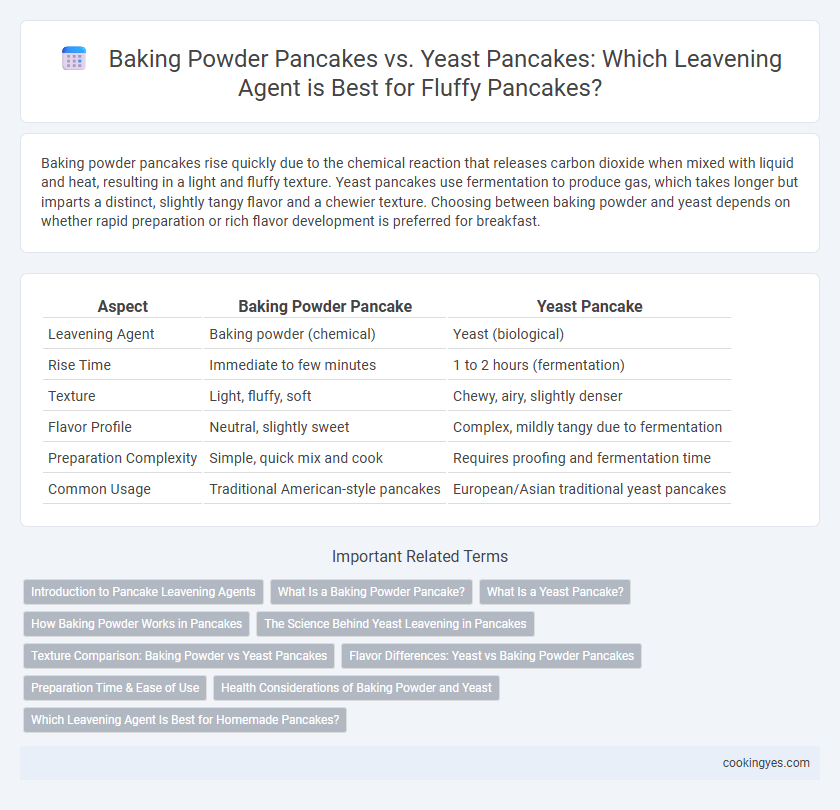Baking powder pancakes rise quickly due to the chemical reaction that releases carbon dioxide when mixed with liquid and heat, resulting in a light and fluffy texture. Yeast pancakes use fermentation to produce gas, which takes longer but imparts a distinct, slightly tangy flavor and a chewier texture. Choosing between baking powder and yeast depends on whether rapid preparation or rich flavor development is preferred for breakfast.
Table of Comparison
| Aspect | Baking Powder Pancake | Yeast Pancake |
|---|---|---|
| Leavening Agent | Baking powder (chemical) | Yeast (biological) |
| Rise Time | Immediate to few minutes | 1 to 2 hours (fermentation) |
| Texture | Light, fluffy, soft | Chewy, airy, slightly denser |
| Flavor Profile | Neutral, slightly sweet | Complex, mildly tangy due to fermentation |
| Preparation Complexity | Simple, quick mix and cook | Requires proofing and fermentation time |
| Common Usage | Traditional American-style pancakes | European/Asian traditional yeast pancakes |
Introduction to Pancake Leavening Agents
Baking powder pancakes use a chemical leavening agent that reacts quickly with moisture and heat, producing carbon dioxide for an immediate rise, resulting in a light and fluffy texture. Yeast pancakes rely on biological fermentation, where yeast consumes sugars and releases carbon dioxide over a longer period, creating a slightly denser, more complex flavor and texture. Understanding these leavening differences helps choose the desired pancake style, balancing convenience and taste preferences.
What Is a Baking Powder Pancake?
A baking powder pancake uses a chemical leavening agent that releases carbon dioxide when mixed with wet ingredients, causing the batter to rise quickly and produce a light, fluffy texture. This type of pancake is preferred for its convenience and fast preparation compared to yeast pancakes, which require time to ferment and develop a distinct flavor. Baking powder pancakes are commonly found in American-style recipes, delivering a tender crumb and consistent rise without the need for prolonged proofing.
What Is a Yeast Pancake?
A yeast pancake uses yeast as its leavening agent, which causes the batter to ferment and produce carbon dioxide, resulting in a light, airy texture with a slightly tangy flavor. Unlike baking powder pancakes, yeast pancakes require time to rise and develop complex flavors during fermentation. This natural fermentation process distinguishes yeast pancakes from quick-rise baking powder pancakes, providing a unique taste and texture.
How Baking Powder Works in Pancakes
Baking powder releases carbon dioxide gas through an acid-base reaction when moistened and heated, creating bubbles that cause pancake batter to rise and become fluffy. This chemical leavening acts quickly, providing a consistent rise without requiring fermentation time like yeast. Pancakes made with baking powder achieve a light texture and tender crumb more rapidly than yeast-leavened varieties.
The Science Behind Yeast Leavening in Pancakes
Yeast leavening in pancakes relies on microbial fermentation, where yeast metabolizes sugars to produce carbon dioxide and ethanol, causing the batter to rise and develop a light, airy texture. This biological process also produces flavor compounds enhancing the pancake's aroma and complexity, distinguishing it from the chemical reaction of baking powder. Understanding yeast's enzymatic activity and fermentation time is crucial for optimizing rise and texture in yeast-leavened pancakes.
Texture Comparison: Baking Powder vs Yeast Pancakes
Baking powder pancakes have a light and fluffy texture with quick-rise leavening, producing a tender crumb and even air pockets. Yeast pancakes develop a chewier, more complex texture with slight tanginess due to fermentation, creating irregular holes and a denser crumb. The choice of leavening agent directly influences pancake thickness, softness, and overall mouthfeel.
Flavor Differences: Yeast vs Baking Powder Pancakes
Yeast pancakes develop a distinct, slightly tangy flavor due to fermentation that enhances depth and complexity, while baking powder pancakes have a more neutral, straightforward taste with a soft and fluffy texture. The fermentation process in yeast pancakes also contributes subtle, savory notes that evolve during proofing, creating a richer flavor profile. Baking powder pancakes offer convenience and consistent rise but lack the nuanced taste that yeast fermentation imparts.
Preparation Time & Ease of Use
Baking powder pancakes require significantly less preparation time, often ready to cook within minutes, making them ideal for quick meals. Yeast pancakes involve a longer rising period of 1 to 2 hours, demanding additional patience and precise temperature control. Baking powder offers consistent leavening with simpler mixing, whereas yeast requires active management for fermentation and flavor development.
Health Considerations of Baking Powder and Yeast
Baking powder pancakes rise quickly due to chemical leavening agents that produce carbon dioxide, but some formulations may contain sodium aluminum or excessive sodium, which can affect cardiovascular health if consumed in large amounts. Yeast pancakes undergo natural fermentation, promoting beneficial probiotic growth and improved digestion, making them generally a healthier option for gut health. However, yeast requires longer preparation time and may cause bloating in sensitive individuals, whereas baking powder pancakes offer convenience with potentially less digestive impact.
Which Leavening Agent Is Best for Homemade Pancakes?
Baking powder pancakes rise quickly due to the chemical reaction that produces carbon dioxide, creating a light and fluffy texture ideal for quick homemade breakfasts. Yeast pancakes develop a more complex, slightly tangy flavor from fermentation, resulting in a chewier and airier texture, but require longer preparation time. For convenience and consistent fluffiness, baking powder remains the best leavening agent for most homemade pancake recipes.
Baking Powder Pancake vs Yeast Pancake for leavening agent Infographic

 cookingyes.com
cookingyes.com